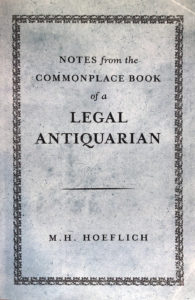M.H. Hoeflich, Notes from the Commonplace Book of a Legal Antiquarian
- March 8th, 2022
- by specialcollections
- in Book Notes
Michael Hoeflich holds degrees from Haverford College, Cambridge University and Yale Law School. He taught at the University of Illinois from 1980-1988, was dean of the Syracuse University College of Law from 1988-1994, and was dean at the University of Kansas School of Law from 1994-2000. Hoeflich is the author or editor of more than 15 books and 115 articles.
M.H. Hoeflich, Notes from the Commonplace Book of a Legal Antiquarian (Clark, NJ: Talbot Publishing, 2021).
Everybody who loves printed books can remember one special moment when that love commenced—or perhaps a time when an affinity for books, already germinating, began to reveal itself definitively. For Mike Hoeflich, the revelation came when a beloved college professor let him examine a 17th-century volume of papal biographies. “In that moment,” he writes, “I was reborn as a bibliophile and collector of texts” (p. x).
Few people can afford early modern books, but those of us who want to read will find a way to do so—and that is true of any category of print titles. Libraries and museums have existed since Classical times; there is a robust, mostly affordable market for out-of-print books; and of course there are now many titles, some of great age, available in one or another of the e-book formats, including hand-held book simulacra. But there is a problem that has been affecting all readers since the days of papyrus scrolls, and that certainly affects us all in these days of information overload. That is, how to remember what has been read?
Some of us try to remember by means of underlining, marginal notes, or highlighting. Some people may even construct “Memory Palaces.” But early modern readers—indeed, many readers well into the 19th century—preserved their reading pleasures by means of Commonplace Books. These were notebooks into which a reader copied excerpts of personal significance. These were typically chosen for their wisdom of sentiment, beauty of language, or pertinence to whatever the copier was thinking or doing. One could navigate one’s Commonplace Book(s) by means of mnemonic devices, personal indexes, marginal notations, or simply by reading over the entries at intervals. What remained when all the copying was done was a very personal document, from the physical look of the notebook, to the character of the handwriting, to the nature of the excerpts. All of these factors reflect the personality of the compiler across a span of time.
Mike Hoeflich, in this latest of his many books, has offered his readers—his friends, as he graciously calls us—a selection of a dozen or so excerpts from his Commonplace collection. One of the first (pp. 3-6) is by a poet styling himself George Coleman the Younger. His poem, titled “A Reckoning with Time,” was published in 1814. One stanza stands out to this reader:
For thou hast made me gaily tough;
Inured me to each day that’s rough,
In hopes of calm tomorrow; —
And when, old Mower of us all!
Beneath thy sweeping scythe I fall,
Some few dear friends will sorrow.
Another entry from Hoeflich’s books is an eighteenth-century essay (pp. 12-21) on “The Antiquity of the Laws of This Island,” a somewhat breathless romp through the Laws of the Britons, Romans, Saxons, Danes, and Normans. The author, like any good Enlightenment historian, seems to have made some things up as he went along. He concludes, though, that “the British laws were altered by the Romans; theirs by the Saxons; and theirs again much altered by the Danes, which mingled with some points of the Saxon law, and fewer of the Norman law, is the common law now in use” (p. 19).
An excerpt from The Comic Blackstone of 1846 (p. 37) also harks back to early medieval times, when the Court of Common Pleas had no fixed location. At that time, says the author, the court “had a van to carry the barristers’ bench, the judge’s easy chair, and the rostrum for the witnesses, from place to place; but when it [the court] became fixed, it made it worth the while of respectable people to study the law, which was not the case when the legal profession was nothing but a strolling company.”
Hoeflich also treats us to a look (pp. 25-27) at the menu of the Austin Law Club, which met at the Parker House in Boston on April 21, 1893. The Austin Law Club, he tells us, was an organization of Harvard Law graduates. Looking over the seven courses they consumed, it is clear that they had not taken vows looking toward ascetic or self-denying lives.
All in all, Mike Hoeflich has given us notable samples of his reading tastes down through the years. His choices in this collection are by turns witty, self-deprecating, satirical, and pointed. It is a pleasure to see, in this way, a lifetime’s reading in miniature. Mike’s Notes will surely please the strolling company of legal historians.
PMP
